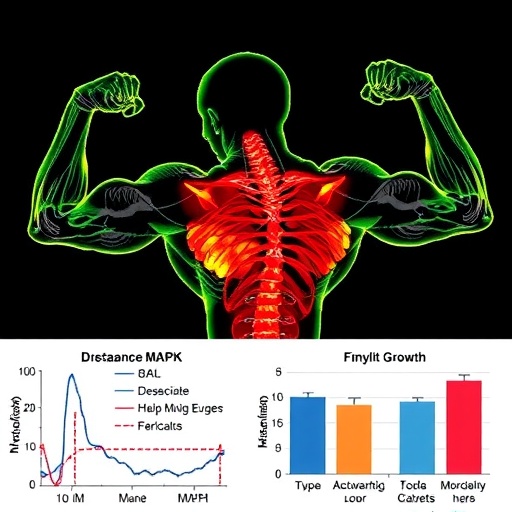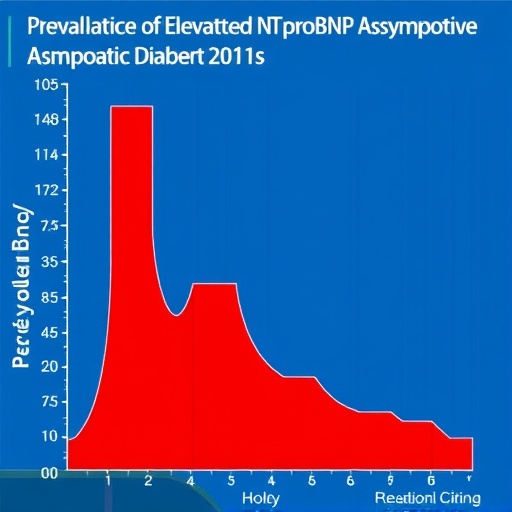
In the quest to unlock the biological secrets behind muscle growth, recent research has shed light on the critical role of mechanically sensitive signaling pathways, specifically the MAPK (mitogen-activated protein kinase) cascade, in mediating the adaptations induced by resistance exercise. This groundbreaking study, led by Bodine and Goodman and published in Nature Metabolism in 2025, provides profound insights into how mechanical stimuli translate into hypertrophic muscle growth at a molecular level, promising new avenues for therapeutic and performance-enhancing strategies.
Resistance exercise is widely recognized as the most effective non-pharmacological intervention to increase skeletal muscle mass and improve functional capacity. Yet, despite decades of research, the exact molecular mechanisms that convert mechanical load into the molecular signals triggering muscle protein synthesis and hypertrophy have remained incompletely understood. This study focuses on dissecting the signaling events downstream of mechanical stimuli, highlighting the MAPK signaling pathway’s pivotal function, which can dynamically sense mechanical changes and orchestrate cellular responses that culminate in muscle growth.
Skeletal muscle is a highly adaptable tissue capable of sensing and responding to alterations in mechanical environment through a complex network of sensors and signaling molecules. Among these, the MAPK pathway stands out due to its involvement in various cellular processes including proliferation, differentiation, and stress responses. Bodine and Goodman’s research elegantly demonstrates that mechanical load generated during resistance training activates specific components of the MAPK pathway, setting off a cascade of phosphorylation events that ultimately modulate gene expression and protein synthesis essential for muscle hypertrophy.
.adsslot_4YjnbJ7u3V{width:728px !important;height:90px !important;}
@media(max-width:1199px){ .adsslot_4YjnbJ7u3V{width:468px !important;height:60px !important;}
}
@media(max-width:767px){ .adsslot_4YjnbJ7u3V{width:320px !important;height:50px !important;}
}
ADVERTISEMENT
In their experiments, the authors subjected muscle fibers to controlled mechanical stretching and resistance-based mechanical overload, measuring subsequent signaling activity with high-resolution biochemical and molecular techniques. They observed that the classical MAPKs—ERK1/2, JNK, and p38—showed rapid and sustained activation following mechanical loading. This activation was not merely a downstream effect but exhibited characteristics of mechanical sensitivity, with magnitude and duration correlating strongly to the mechanical strain applied.
One of the most striking findings of this study is the demonstration that these mechanically sensitive MAPKs do not act in isolation but integrate signals from diverse upstream mechanotransducers such as integrins, focal adhesion complexes, and stretch-activated ion channels. This integrative signaling network ensures that muscle cells can finely tune their hypertrophic response based on the quality and quantity of mechanical stimuli, thereby preventing maladaptive growth or muscle damage.
Furthermore, the research delves into the transcriptional consequences of MAPK activation during resistance exercise. The authors report that MAPK signaling enhances the expression of key hypertrophy-related genes including those involved in protein synthesis pathways such as mTOR, as well as genes encoding structural proteins like myosin heavy chains and actin isoforms. These molecular adaptations facilitate the expansion and remodeling of the muscle contractile apparatus, ultimately leading to observable muscle enlargement.
A particularly innovative aspect of this work is its exploration of the temporal dynamics of MAPK signaling. Bodine and Goodman establish that transient, cyclical activation of MAPKs post-resistance training sessions is critical to sustain muscle growth over time. Chronic or dysregulated MAPK activation, on the other hand, may lead to pathological hypertrophy or muscle wasting, highlighting the nuanced regulatory balance maintained by mechanical cues and intracellular signaling circuits.
The study also investigates the interplay between MAPK signaling and other prominent anabolic pathways such as PI3K/Akt/mTOR, underscoring a finely orchestrated cross-talk necessary for robust muscle hypertrophy. MAPK activation appears to prime anabolic pathways as well as modulate autophagy and proteostasis mechanisms, ensuring that muscle growth is efficient, balanced, and adaptable to varying mechanical demands.
Beyond the fundamental biology, the translational implications of identifying mechanically sensitive MAPK signaling as a key driver of muscle hypertrophy are immense. There is strong potential for the development of novel pharmacological agents or exercise mimetics that selectively modulate MAPK activation to treat muscle atrophy associated with aging, disuse, or chronic diseases such as cancer cachexia and muscular dystrophies.
Moreover, understanding the signaling intricacies could inform tailored resistance training protocols optimized to maximize MAPK activation and muscle growth, personalized to individual genetic backgrounds or existing muscle conditions. Such insights may revolutionize sports science and rehabilitation medicine, making resistance exercise prescriptions far more effective and precise.
Importantly, the presence of mechanically sensitive MAPK pathways also raises fascinating questions about evolutionary muscle plasticity. The capacity to effectively couple mechanical stimuli to molecular responses likely conferred significant survival advantages, allowing organisms to adapt rapidly to changes in physical demands through muscle remodeling, an essential feature across diverse species.
Bodine and Goodman’s research further opens avenues to explore how defects or genetic variations in MAPK components contribute to muscle diseases or impaired hypertrophic responses. Future studies could investigate how aging-related attenuation of MAPK signaling impacts sarcopenia, and whether interventions targeting this pathway could rejuvenate muscle function in elderly populations.
The meticulous combination of in vivo mechanical loading models, ex vivo muscle fiber analyses, and cutting-edge molecular biology techniques strengthens the validity and translational relevance of the findings. This multi-dimensional approach enables a comprehensive mapping of mechanically sensitive MAPK signaling events from the cell membrane to the nucleus, illuminating the complexity of muscle adaptation mechanisms.
In summation, the identification of mechanically sensitive MAPK signaling as a critical mediator of resistance exercise-induced muscle growth marks a paradigm shift in muscle biology. This research not only elucidates a fundamental mechanotransduction pathway driving hypertrophy but also charts new directions for enhancing muscle health and performance across the lifespan. The intricate relationship between mechanical forces and muscle plasticity, governed by MAPK cascades, invites further exploration and promises exciting therapeutic innovation in the near future.
Subject of Research: Mechanistically understanding the role of mechanically sensitive MAPK signaling in mediating resistance exercise-induced skeletal muscle hypertrophy.
Article Title: Mechanically sensitive MAPK signalling mediates resistance exercise-induced muscle growth.
Article References:
Bodine, S.C., Goodman, C.A. Mechanically sensitive MAPK signalling mediates resistance exercise-induced muscle growth. Nat Metab (2025). https://doi.org/10.1038/s42255-025-01303-z
Image Credits: AI Generated
Tags: Bodine and Goodman study 2025cellular responses to mechanical stimulihypertrophic muscle growth mechanismsMAPK cascade in muscle growthmechanically sensitive signaling pathwaysmolecular signals in muscle protein synthesisNature Metabolism publication on muscle growthnon-pharmacological interventions for muscle massresearch on muscle growth pathwaysresistance exercise adaptationsskeletal muscle adaptability and signalingtherapeutic strategies for muscle enhancement





